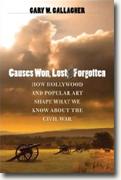Causes Won, Lost, and Forgotten
Gary W. Gallagher
book reviews:
· general fiction
· chick lit/romance
· sci-fi/fantasy
· graphic novels
· nonfiction
· audio books
· author interviews
· children's books @
curledupkids.com
· DVD reviews @
curledupdvd.com
newsletter
win books
buy online
links
home
for authors
& publishers
for reviewers

 |
Causes Won, Lost, and Forgotten: How Hollywood and Popular Art Shape What We Know about the Civil War Gary W. Gallagher The University of North Carolina Press Hardcover 288 pages April 2008 |
|
Gary Gallagher examines the influence that Hollywood movies and a variety of arts have on what people today know about the Civil War. Movies have a major influence, and what they present is not always accurate historical fact. Many times the history has been changed to improve story flow, for some other artistic reason - even for a particular propaganda reason.
The Union Cause, which is Northern and some Southern support for the Federal government, says that neither the South nor any state can secede from the Union. Here Abraham Lincoln, Ulysses S. Grant, William T. Sherman, and others are portrayed as heroes; slavery, however, is not its primary focus - that became a secondary focus during the war. The Emancipation Cause, concerned with the freeing of the slaves, considers the Civil War to have been fought to free African Americans from slavery, a group consisting of African Americans and, originally, abolitionists. Their heroes are Abraham Lincoln, Frederick Douglass, and blacks who served in the military. The Reconciliation Cause wants the North and the South to live in peace and to reunite the Union. Their hero is also Abraham Lincoln, who gave his life to reunite the country. Gallagher reviews movies and various arts to see which cause or causes each promotes, movies including Gods and Generals, Gone with the Wind, Gettysburg, Shenandoah, Andersonville, Birth of a Nation, Ride with the Devil, Cold Mountain, Glory, How the West Was Won, and others. He uses three major magazine on the Civil War - Civil War Times Illustrated, Blue & Gray Magazine, and North & South - to research what subjects depicted in art have been available according to the four causes or North versus South. He discovered that more Confederate subject art is purchased or available than is Union subject art, reviewing Mort Kunstler, Keith Rocco, Dale Gallon, Don Troiani, John Paul Strain, and artists of long ago. Gallagher found that the Lost Cause of the Confederacy is popular, even if some of its propaganda is historically wrong; some of the Southern heroes are overly glorified, almost diefied. The Union Cause is not very popular, although the Union won the war. Abraham Lincoln is the hero for the Union, Emancipation and Reconcilation causes especially since he is seen as a martyr for those causes. The Emancipation Cause in recent times has been taken up by African Americans; the movie Glory is its prime example. Gallagher provides many illustrations from movies and art, as well as endnotes and an index. Causes Won, Lost, and Forgotten Gary W. Gallagher is the John L. Nau III Professor of History at the University of Virginia and the author of the upcoming book Two Witnesses at Gettysburg (Jan. 2009). He is the author of Lee and His Army in Confederate History (2000), The Antietam Campaign (1999), editor of The Wilderness Campaign (1997), and author of The Fredericksburg Campaign (1995) and of many other books and articles. Originally published on Curled Up With A Good Book at www.curledup.com. © Br. Benet Exton, O.S.B., 2008 |
| Also by Gary W. Gallagher: |
|
|
|
 Click here to learn more about this month's sponsor! |
|
| fiction · sf/f · comic books · nonfiction · audio newsletter · free book contest · buy books online review index · links · · authors & publishers reviewers |
|
| site by ELBO Computing Resources, Inc. | |
 Gallagher identifies four causes (or ideologies, or even propagandas) that influence a movie or a piece of art. The Lost Cause refers to the Confederate or Southern cause that avers that the South was right to secede from the Union and that the war was for them a defensive one – that they were only defending themselves against the Northern aggressor. This cause presents Robert E. Lee, Thomas “Stonewall” Jackson, and sometimes Jefferson Davis and others as righteous heroes who lost only because they were outnumbered, and that their economy and way of life was destroyed by the North.
Gallagher identifies four causes (or ideologies, or even propagandas) that influence a movie or a piece of art. The Lost Cause refers to the Confederate or Southern cause that avers that the South was right to secede from the Union and that the war was for them a defensive one – that they were only defending themselves against the Northern aggressor. This cause presents Robert E. Lee, Thomas “Stonewall” Jackson, and sometimes Jefferson Davis and others as righteous heroes who lost only because they were outnumbered, and that their economy and way of life was destroyed by the North.